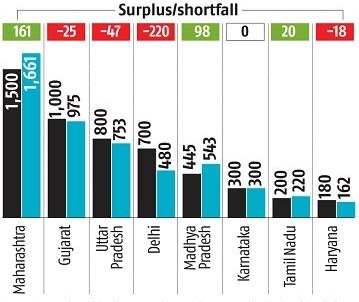Indian Economy
Oxygen Crisis: Covid-19
- 28 Apr 2021
- 4 min read
Why in News
The Liquid Medical Oxygen (LMO) crisis during the second wave of Covid surge has been precipitated by a shortage of tankers and the daunting logistics of transportation from distant locations.
Key Points
- Liquid Medical Oxygen:
- It is high purity oxygen suitable for use in the human body. So, it is used for medical treatments.
- This oxygen provides a basis for virtually all modern anaesthetic techniques, restores tissue oxygen tension by increasing the oxygen availability, aids cardiovascular stability, etc.
- The World Health Organisation includes this on their List of Essential Medicines.
- According to the Drug Prices Control Order, 2013, LMO is placed under the National List of Essential Medicines (NLEM).
- LMO Production in India:
- India has a daily production capacity of at least 7,100 Metric Tonnes (MT) of oxygen, including for industrial use.
- Due to the crisis, the production has been increased to 8,922 MT. And approximately daily sale is 7,017 MT.
- The domestic production is expected to cross 9,250 MT per day by the end of April 2021.
- Therefore, India appears to be producing sufficient oxygen to meet the current need.
- Reasons for the Crisis:
- Distance of Production Plants:
- Most of the LMO plants are located in the east, leading to long transportation hauls and a turnaround time of at least 6-7 days for each tanker. Add to this the problem of states holding up tankers on the way.
- Limited Tankers:
- At present, India has 1,224 LMO tankers with a cumulative capacity of 16,732 MT of LMO. This is grossly inadequate because at any given point, there are only 200 tankers in transit to meet a demand of 3,500-4,000 MT.
- Companies not Buying Cryogenic Tankers:
- Cryogenic tankers cost around Rs. 50 lakh each. Companies are not buying these tankers because once this wave is over, that investment will turn into losses.
- Cryogenic Tankers: These are tankers which store medical oxygen at -180 degrees C, have double-skin vacuum-insulated containers, including an inner vessel made of stainless steel.
- Cryogenic tankers cost around Rs. 50 lakh each. Companies are not buying these tankers because once this wave is over, that investment will turn into losses.
- Leakage and Irrational Use:
- In the past, the Health Ministry repeatedly demanded hospitals to reduce wastage and unnecessary oxygen use in Hospitals. Industrial experts also raised concerns over possible leakages in hospital pipelines that supply oxygen.
- Black marketing of oxygen cylinders is another issue.
- Distance of Production Plants:
- Government Initiatives:
- Oxygen Express:
- Trains to transport LMO and oxygen cylinders across the country have been started to fight the ongoing crisis.
- Disaster Management Act 2005:
- The Ministry of Home Affairs invoked Disaster Management Act, 2005 (DM Act) and ordered free inter-state movement of oxygen carrying vehicles.
- Restarting Plants:
- The government is restarting many closed plants to increase the supply of LMO, for example, Sterlite plant in Tamil Nadu will be reopened for 4 months to provide oxygen supply.
- Use of Air Force:
- To speed up the transportation, Indian Air Force (IAF) is airlifting empty oxygen tankers and taking them to industrial units that have switched to producing medical grade oxygen.
- Oxygen Enrichment Unit (OEU):
- It is developed by scientists of Council of Scientific and Industrial Research-National Chemical Laboratory (CSIR-NCL), and will help reduce the requirement of ventilators and oxygen cylinders in homecare, villages and remote places.
- Oxygen enrichment units have special significance in view of the Covid-19 pandemic. Patient recovery can be faster with supplemental oxygen in early stages.
- Oxygen Express:





